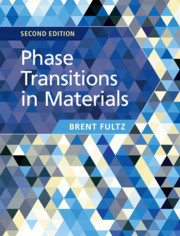Book contents
- Frontmatter
- Contents
- Preface
- Notation
- Part I Basic Thermodynamics and Kinetics of Phase Transformations
- Part II The Atomic Origins of Thermodynamics and Kinetics
- 6 Energy
- 7 Entropy
- 8 Pressure
- 9 Interactions in Microstructures and Constrained Equilibrium
- 10 Atom Movements with the Vacancy Mechanism
- Part III Types of Phase Transformations
- Further Reading
- References
- Index
9 - Interactions in Microstructures and Constrained Equilibrium
from Part II - The Atomic Origins of Thermodynamics and Kinetics
Published online by Cambridge University Press: 24 April 2020
- Frontmatter
- Contents
- Preface
- Notation
- Part I Basic Thermodynamics and Kinetics of Phase Transformations
- Part II The Atomic Origins of Thermodynamics and Kinetics
- 6 Energy
- 7 Entropy
- 8 Pressure
- 9 Interactions in Microstructures and Constrained Equilibrium
- 10 Atom Movements with the Vacancy Mechanism
- Part III Types of Phase Transformations
- Further Reading
- References
- Index
Summary
Interactions between different physical processes often make rich contributions to phase transformations in materials. The slow kinetics of one physical process can alter the thermodynamics of another process, confining it to a “constrained equilibrium,”sometimes a local minimum of free energy called a “metastable” state. A first example is the formation of a glass, which we approach with the simplest assumption that some state variables remain constant, while others relax towards equilibrium. Sometimes “self-trapping” occurs, when the slowing of a one variable enables the relaxation of a slower second variable coupled to it, and this relaxation impedes changes of the first variable. Couplings between interstitial and substitutional concentration variables are shown to alter the unmixing of both. Coherency stresses in two-phase materials are described. This chapter develops thermodynamic relationships between the different degrees of freedom of multiferroic materials, with a focus on the extensive variables that are closer to the atoms and electrons. The chapter concludes by addressing more deeply the meaning of “separability,” showing some of its formal thermodynamic consequences.
Keywords
Information
- Type
- Chapter
- Information
- Phase Transitions in Materials , pp. 223 - 249Publisher: Cambridge University PressPrint publication year: 2020
